by Jochen Szangolies
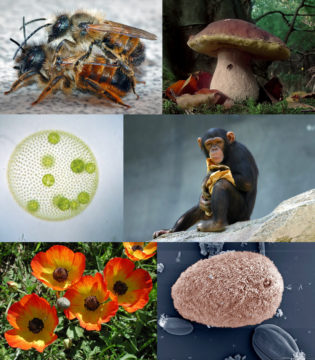
In the 1994 science fiction film Star Trek Generations, while attempting to locate the missing Captain Picard, Lt. Cmdr. Data is given the task to scan for life-forms on the planet below. Data, an android having recently been outfitted with an emotion chip, proceeds to proclaim his love for the task, and makes up a little impromptu ditty while operating his console, to the bewilderment of his crew mates.
The scene plays as comic relief, but is not without some poignancy. The status of Data himself, whether he can be said to be himself ‘alive’ and therefore worthy of the special protection generally awarded to living things, is a recurring plot thread throughout the run of Star Trek: The Next Generation. In his struggle to become ‘more human’, his attainment of emotions marks a major milestone. Having thus been initiated into the rank of an—albeit artificial—life-form, one might cast his task as not so much a scientific, but a philosophical one: searching for others of his kind.
It is then somewhat odd that there is apparently a mechanizable answer to the question ‘what is life?’, some algorithm performed on the appropriate measurement data returning a judgment on the status of any blob of matter under investigation as either alive or not. If there is some mechanical criterion separating life from non-life, then how was Data’s own status ever in question?
Life outrunning any myopic human definition of the term is a perennial staple of science fiction. Define life as carbon-based, and Steven G. Weinbaum, in A Martian Odyssey, imagines a creature of silicon, creating little pyramids of silica bricks as its waste. Define it as planetary, and Fred Hoyle proposes an interstellar black cloud, in the eponymous story. Life not based on chemistry, but on processes governed by the strong nuclear force, existing in the deep gravitational well of a neutron star, has been described by Robert L. Forward in Dragon’s Egg. Virtually any characteristic of life one might think to call essential can, and probably has, been questioned in fiction.
But there is one aspect of life that I’m especially interested in here that is more rarely challenged: that, wherever it exists, it does so in a certain form—that is, that life is essentially a collection of various kinds of individual entities. When people are asked to imagine what life might be like on other planets, answers might run the gamut from pointy-eared humanoids to tentacle-faced abominations, but they’ll typically be alike in that they depict clearly separated individuals—the ‘tiny little life-forms’ Data aims to find.
To be sure, this intuition, too, has been questioned in science fiction. The ocean in Stanisław Lem’s Solaris is perhaps the most famous example of ‘non-individual’ life. A particularly vivid take is also provided by Peter Watts’ short story The Things, a retelling of sci-fi classic The Thing from the alien’s perspective, to which the idea of life ‘pinched off and frozen into these freakish shapes’ is anathema, even horrendous. Even in Star Trek, usually famous for portraying aliens as pretty much like humans with bumpy foreheads and some mild eccentricities of character, an example exists in the so-called Founders, an alien race whose natural state is a gooey conglomeration referred to as the Great Link.
Still, when we think of life, we think of life-forms: literally, life cast into a certain shape—small or large, hard or soft, but clearly delineated into individual entities. But this may be a mistake; and we don’t need to travel to the stars to realize this.
Being One, Being Many
In fact, we need not cast our gaze further than the ground beneath our feet. But first, let us see where the tendency to view life as a collection of individual entities, of life-forms, might come from, and whether it is appropriate.
Life around us seems to come in neat packages. There’s the house cat, there’s your friends Sarah, Tom, and Rebecca, there’s the plants in their pots, the blades of grass on the ground, the insects buzzing around. But as soon as we look a little closer, the boundaries begin to blur.

On each of Sarah’s, Tom’s, and Rebecca’s faces, there’s likely to be a population of up to a million mites of the genus Demodex, roughly 0.3 mm long creatures that live exclusively on human skin, feeding on dead cells and sebum. The gut, moreover, is home to between 300 and 1,000 species of bacteria, which makes it the place with the highest microbial density of any habitat on Earth. More than 100 species of fungi have been found in the human mouth alone.
From up close, the static individual dissolves into a mess of microscopic motion, crawling mites, wriggling worms, and twitching bacteria. We start to look not so much like forms of life, but rather like habitats. What, then, should Data’s scanner show, if pointed at us: one life-form—or millions?
Still, though, that we might have become colonized does not, in itself, threaten the notion of the individual life-form. A rider on a horse is still just two individuals, not one new centaur-like chimera. But our microbiome does more than merely inhabit us; rather, it provides us with essential functions, loss of which can threaten our well-being, as anybody who has had their gut flora decimated by a prolonged course of antibiotics can attest to. So, where horse and rider are functionally independent, and each quite capable to flourish without the other, we are not so easily separated from at least some of the creepy crawlies that call our body their home.
There are more pointed examples of symbiotic relationships in the animal kingdom. In their article A Symbiotic View of Life: We Have Never Been Individuals, authors Gilbert, Sapp, and Tauber present cases of developmental symbiosis, where individuals of one species are unable to reach maturity without the aid of another. One example is the butterfly Maculinea arion, whose larvae mimic the smell of those of a certain species of ant, causing its members to carry them into their nests, caring for them as their own.
Other notions of individuality flounder likewise. Genetically, a clear differentiation is often not possible: in the mealy bug Planococcus, the enzymes needed for the synthesis of amino acids are coded for by genes distributed among the host and two bacterial symbionts, such that neither species has a ‘complete’ genome on its own. Even the immune system, often considered the ‘gatekeeper’ of the body, capable of distinguishing between ‘self’ and ‘other’, cannot be used as an unequivocal individuating criterion. Without assistance by the resident microbiota, immune system response is often diminished, and its development hampered.
With the notion of the individual life-form thus diminished, a growing consensus points to the holobiont, a host organism together with its various symbiotic bacteria, fungi, and viruses, as the natural ‘unit’ of life. However, by and large, this is still a discrete concept: it makes sense to talk about various individual holobionts, even if each cannot be clearly associated with any given single life-form. But even this discreteness is questionable.
Unbranching In The Tree Of Life
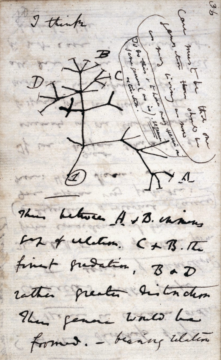
Life evolves, we learn in school, in a way that mirrors the branching of a tree: two or more present-day species might share a common ancestor, from which they have developed into their current form by means of mutation and differential selection, as prompted by differences in the environment. The opposite process, the merging of branches into a novel form, seems absent from this story. Yet, as is nowadays widely accepted, some of the most momentous developments in the history of life are due to exactly this process.
This is the content of the theory of symbiogenesis, also known as the endosymbiontic theory. This idea was first formulated by Russian botanist Konstantin Mereschkowski, then brought into its modern form and substantiated by detailed microbiological analysis thanks to the tireless work of Lynn Margulis—often against the staunch opposition of her colleagues. In its most straightforward form, it states that the modern eukaryotic cell—the type of cell with a nucleus (káryon) all ‘macroscopic’ life consists of—has its origin in the fusion of procaryotic, bacteria-like cells. The two most commonly cited examples are the mitochondria providing chemical energy, and the chloroplasts giving plant cells their ability to photosynthesize.
But similar, at least in spirit, examples also exist on the larger scale. Lichen are composites of algae and/or cyanobacteria (the photobiont) living within the filaments of certain fungi (the mycobiont). Thus, they may include elements of three different kingdoms of life in a mutually co-evolving relationship, calling the taxonomic instinct of strictly differentiating between genera of living entities into question. The key point of Gilbert, Sapp, and Tauber then is that this isn’t a rare oddity, but that indeed, as they conclude, ‘we are all lichens’—complex symbiotic entities that resist strict individuation.
The humble lichen has another lesson to teach us, which calls into question the notion of reproductive identity. The usual story we’re told of what happens when a mommy and a daddy love each other very much is already complicated by the tens of thousands of different sexes present in certain fungi. Yet, lichen throw even more of a spanner into the works of heteronormative ideas of sexual reproduction and vertical genetic inheritance (from parents to offspring). As argued by David Griffiths in his article Queer Theory for Lichens, sexual reproduction is really just a small corner of the general reproductive landscape: we reproduce our own livers every two months and our stomach linings every five weeks, and the human body is “a teeming multispecies ecosystem that is constantly engaged in reproduction, connections and transfer outside of the narrow understanding of sexual reproduction in heteronormative public discourse”.
In this sense, the traditional understanding of reproduction becomes a rare event, perhaps more akin to the founding of a new city or state, itself teeming with constant reproductive activity. But if all of this ‘internal’ reproduction still preserves our individuality, if we’re the same now that we were untold cell divisions ago, then where does the cutoff lie where same suddenly becomes different?
Griffith’s larger point is that this shift of biological understanding has bio-political importance: rather than understanding the social individual as something that can play either the male or the female part in the grand drama of life, an unbiased examination of biological reality shows us that far more diverse roles are available. Similarly, rather than understanding life—and by extension, society—as a collection of individuals, thinking of individuals as localized foci of life may ultimately be more natural.
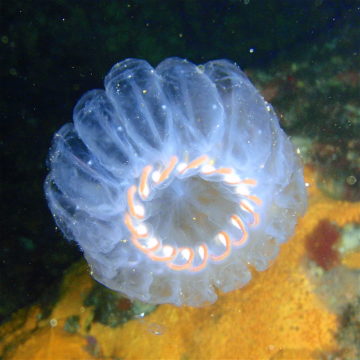
For another example, take the humble salp, which has two reproductive stages: a solitary, asexual stage (the oozoid), and a sexual stage composed of a chain of clones (blastozooids) of the initial individual. At first, all members of this chain are female, and are fertilized by sperm from older chains, giving live birth to new solitary individuals, for the cycle to repeat; as it matures, the chain then turns male. Which is the individual—the chain, or each clone?
One Life, Many Forms
As we have seen, so far, the notion of the insular biological entity, the life-form, becomes difficult to uphold, in light of the ubiquity of symbiosis and symbiogenesis, of fluid sexes and horizontal genetic transfer. But still, life seems to occur in distinct forms: while age and circumstance may shape us, we still remain, substantially, the same sort of thing. The changes we experience are bounded in such a way that it is in general fairly easy to differentiate between human and non-human, pointy-eared aliens notwithstanding.
But counter-examples here are also easily found. Consider the caterpillar and the butterfly: confronted with each separately, it would not occur to us that they are just different stages of the life cycle of the same animal. The process of metamorphosis yields what the philosopher Emanuele Coccia, in his book of the same name, terms ‘one life in two bodies’: two entirely distinct, yet inextricably related, appearances. Two life-forms, but just one life.
Life, it seems, overflows any bins we might attempt to contain it in, outruns any discrete concepts we use to capture it. It cannot be simply cast into various shapes as into a mould, to produce individual life-forms as a result. Even the dichotomy between ‘alive’ and ‘dead’ may be called into question. Take the hydra, a simple freshwater cnidarian with the capability of continually renewing parts of itself, even regrowing copies after being sliced into bits, potentially leading to biological immortality. Or consider the ‘immortal jellyfish’ Turritopsis dohrnii, which cheats death by simply reverting to a juvenile stage, starting the aging process all over again (although I’m not sure I’d be in favor of this as an option for human immortality—I mean, who really wants to go through their awkward teenage years all over again…).
The boundaries between alive and dead, organism and environment are more blurry than is usually assumed. Your hair, your fingernails, are part of you as a living entity, but are generally considered to be ‘dead cells’; as is the outer protective layer of your skin. Similarly, certain living beings have ‘out-sourced’ parts of their biological function to the environment: termites of the genus Macrotermes utilize colonies of the fungus Termitomyces to act as a kind of ‘environmental digestive system’, breaking down the cellulose and lignin found in wood into a more palatable nutrient paste. Certain fungi release enzymes into the environment, digesting their food externally, essentially co-opting the surrounding soil as part of their digestive apparatus.
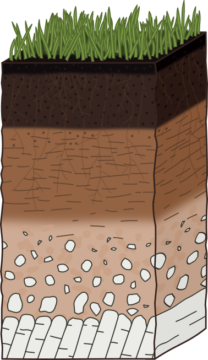
Finally, soil itself can, for many purposes, be regarded as a living thing. It is a mixture of both organic and inorganic compounds, carrying out complex biological functions, shot through with mushroom mycelia that themselves may live in complex symbiotic relationships with plant root systems, transferring nutrients between different individuals or even species. It grows, and it breathes; it digests fallen leaves, making them part of itself. It can be healthy, or unhealthy—it can even die. In that sense, soil might be the ultimate foil to the idea of the life-form: like Lem’s ocean or the Founder’s Great Link, it is an amorphous continuum, rather than a collection of discrete elements. Life without the form. The ground beneath our feet is not just dirt, but part of the same life as you and me.
This unity extends beyond the forms life takes, encompassing its behavior. Action, one might hold, still is taken at the locus of the individual; but individuals can band together, like a school of fish or a flock of birds, or a colony of ants, acting as one. Indeed, the evolution of multicellularity, the second great coming together after symbiogenesis, is just a logical end-point of individuals acting together for mutual benefit, finding its echo in the clonal chains of salps, the specialized roles of individual bees in the hive, or the collective action taken by a swarm to evade a predator—action which cannot be said to originate with any individual member of the swarm.
Perhaps, then, life is not best thought of as a collection of life-forms; rather, life-forms are just approximate, localized appearances of one and the same life, like the fruiting bodies of mushrooms are just localized outgrowths of one and the same subterranean mycelium, that might, unseen, stretch through acres of soil. Life resists the attempt of being confined to clear concepts—and therefore, something like Data’s scanner can never yield an unambiguous answer.
Towards An Ecological Ethics
The same life that finds an expression in you and me, is expressed in the animals of the woods, the plants in the fields, the fungi on the ground, and perhaps, the soil itself. Thus, we are not separate from them, and neither are they from each other: rather than a struggle of all against all, ‘red of tooth and claw’, the history of life becomes radically recast as one of symbiotic relationships, one not just of branching, but also of merging, or perhaps, of re-integrating the unity encompassing life in all its forms.
Such a notion of life’s unity should not be confused with the Gaia hypothesis, originated by the chemist James Lovelock. This idea posits that the entirety of life on Earth, together with its surroundings, forms a self-regulating, co-evolving system—itself sharing certain characteristics of life, such as the perpetuation of homeostasis. Rather, it proposes that life, as such, is not reducible to the sum total of the forms it takes, like the life of the butterfly is not reducible to its larval or winged form, but equally expressed in both.
This has some resonance with certain concepts from Buddhist thought. Consider the notion of nonduality, the idea that we are not separate from each other and from the world—that the world, or life, not simply decomposes into a collection of individuals. A remarkable implication of this sort of thinking is that ultimately, all harm is self-harm: if you and me are not fundamentally distinct, then the harm I cause you is harm I cause myself. This makes harming others simply irrational, and thus, any attempt to harm others makes sense only in the context of being confused about the fundamental, nondual nature of life.
If one hand cuts off a finger of the other, it is not that this hand has hurt the other, but rather, an act of self-harm. So, too, are acts of harm perpetrated by us against other manifestations of the life we ourselves belong to—harm against animals, against plants, against the environment more generally, is ultimately self-harm. This neatly end-runs the difficult question of moral responsibility, particularly towards others: even if I agree that hurting others is bad, and not hurting them is good, why should I do what is good, and refrain from doing what is bad? Because it is good to do what is good?
Self-harm, on the other hand, is simply irrational. If you cut off another’s finger, that would be morally damnable; but if you cut off your own, we might hold that while you may have a right to do so—it’s your finger, after all—cutting off a perfectly good finger would just be, well, stupid, or at least irrational. In such a case, an apt reaction would be therapy, rather than jail time—help, rather than punishment.
It might be objected that cutting off their own finger hurts the individual wielding the knife, and it is this, the centredness of the suffering, that makes it an act of self-harm. In hurting others, it is they who suffer—and hence, they who are harmed. But even if the hand was anesthetized, eliminating the suffering, the act would be one of self-harm: it is not (just) the suffering, but the needless reduction in capabilities that makes the act irrational. Actions requiring the use of that finger become unavailable to you, and reducing your possibilities needlessly cannot be rational.
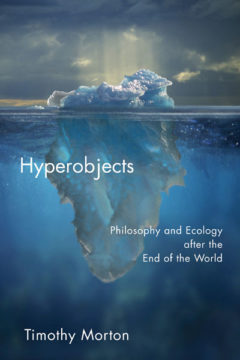
There is another, less immediate implication of the thesis of the unity of life. The philosopher Timothy Morton has introduced the idea of the hyperobject—an entity so massively distributed in time and space as to resist appearing as a whole in individual perception, transcending spatiotemporal notions. Examples could be the totality of all oil on Earth, the trash in all the landfills—or, for instance, vast, catastrophic complexes like anthropogenic global warming.
The hyperobject’s vastness makes it nigh impossible to engage with—indeed, to even comprehend, to accept. As in the presence of a Lovecraftian cosmic horror, the individual human, faced with the hyperobject, shrinks into meaningless nothingness. No wonder denial is such a frequent reaction to this confrontation. And when denial becomes unsustainable, despair is the only response left: what change could we—could I—possibly effect, in the shadow of such vastness? What am I but a grain of sand, destined to be washed away in the flood?
But if the above considerations are apt, then we—then life—is not just a handful of grains of sand. Life is itself a hyperobject—indeed, is more than mere object: each living thing is a being, an agent with goals and intentions. Thus life is hyperbeing—not a hyperbeing, but being on the stage of hyperobjects.
That means that we do not stand alone, each of us, isolated, powerless against the looming hyperobjects of global catastrophe (anymore than we are isolated sparks of mind, imprisoned within the bony walls of our crania). Rather, we—life—can meet them on their terms, hyperbeing among hyperobjects, engaging them as equal. Recognizing our nondual nature, shedding the illusion that we’re each just in for ourselves, may be the first step to united action against those hyperobjects that would threaten our flourishing.
All this might sound suspiciously like the sort of conclusion typically reached at 3 a.m. in college dorms around the world. And, well, maybe. But we need not take it as pretending to some ‘whoa, dude’-insight into capital-T Truth. Rather, it might provide an impetus for a shift towards a perspective that emphasizes life’s unity over the isolation of ‘tiny little life-forms’—thus, if not providing new answers, then perhaps at least reframing old questions.
